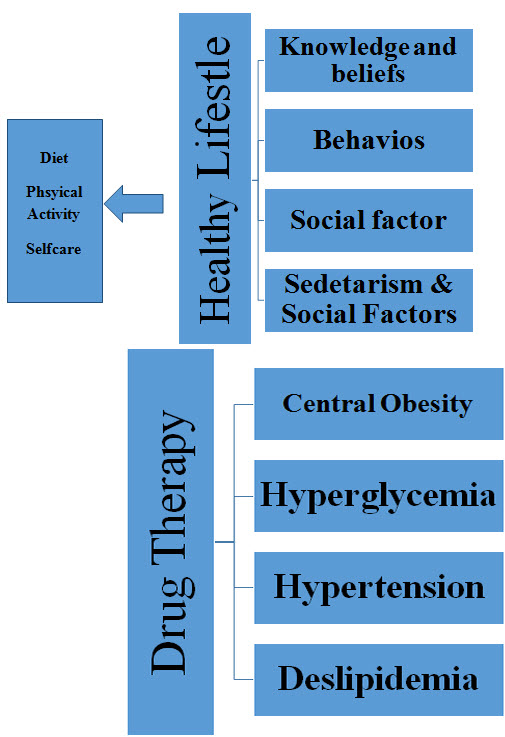ABOUT AUTHOR
Navneet Kaur1, Narinder Singh2, Daisy Sharma2.
1Department of Biotechnology, CT Institute of Pharmaceutical Sciences, Shahpur, Jalandhar-144001, Punjab.
2Department of Pharmaceutics, CT Institute of Pharmaceutical Sciences, Shahpur, Jalandhar-144001, Punjab
ABSTRACT
Metabolic syndrome is defined by a group of interconnected physiological and a few biochemical or clinical disorder which directly affect the high risk rate of diseases such as cardiovascular disease (hypertension) also causing type 2 diabetes mellitus and mortality. The metabolic syndrome is higher prevalence in Western counterparts other than the urban population of some emerging countries. In the review Definition of syndrome, pathophysiology, and some criteria would be proposed for the clinical diagnosis and underlying management approaches for metabolic syndrome.
INTRODUCTION
The metabolic syndrome (MetS) is a common and heightening general wellbeing and clinical test worldwide in the wake of urbanization, surplus energy intake, obesity, and sedentary life habits. MetS gives a 5-crease increment in the danger of type 2 diabetes mellitus (T2DM) and 2-overlay the danger of creating cardiovascular illness (CVD) over the following 5 to 10 years (Grundy, 2016). Encourage, patients with the MetS are at 2-to 4-overlay expanded danger of stroke, a 3-to 4-crease expanded danger of myocardial dead tissue (MI), and 2-crease the danger of passing on from such an occasion contrasted and those without the disorder (Alberti and Zimmet,2005). Paying little mind to a past history of cardiovascular occasions (Olijhoek, et.al 2004). A form of MetS has a WHO Worldwide Classification of Disease (ICD-9) code (277.7) which grants human services repayment. Up to 50 million people in the United States are believed to have the metabolic syndrome and are thus at increased risk of developing atherosclerotic disease. Because of this high prevalence and in order to increase awareness of the syndrome among practicing physicians, several expert bodies have published diagnostic criteria for the metabolic syndrome. MetS is considered as a first request chance element for atherothrombotic intricacies. Its nearness or, then again nonappearance ought to thusly be viewed as a pointer of long haul chance. Then again, the transient (5–10 a long time) hazard is better figured utilizing the established calculations as they incorporate age, sex, add up to cholesterol or LDL, and smoking(Grundy,2006).
Pathophysiology of Metabolic syndrome
MetS is a condition of chronic low grade inflammation as a consequence of complex transaction amongst hereditary and natural components. Abdominal obesity and insulin resistance are seen as the center deformities basic the pathophysiology of metabolic disorder. These two risk factors are profoundly interrelated; in this way, it is hard to determine which one assumes the dominating part in metabolic disorder pathogenesis and movement. Also, metabolic disorder pathophysiology is confused by contributing variables, for example, dysregulation of fat tissue–derived cytokines, aggravation, hereditary qualities, race/ethnicity, physical inertia, eat less carbs, hormone uneven characters, medications, and age. As such, it is impossible to accept that metabolic disorder is brought about by a solitary fundamental deformity. Rather, it is the mix of various hazard variables, principally determined by stoutness and insulin resistance, which offers ascend to the improvement of this grouping of metabolic health risks (Halberg, et.al 2008; Xydakis, et.al 2004; SotoGonz´alez, et al.2006; Martin, et.al 2003).

Figure 01: Pathophysiology of Metabolic syndrome
(FFA: free fatty acid, ATII: angiotensin II, PAI-1: plasminogen activator inhibitor-1, RAAS: renin angiotensin aldosterone system, SNS: sympathetic nervous system.)
Table 01 : Diagnostic criteria proposed for the clinical diagnosis of the MetS.

Figure 02 : A Managements approaches for Metabolic syndrome) (Grundy SM, 2016)

CONCLUSION
The metabolic syndrome is a group of pathophysiologic state that which commonly originates primarily from an imbalance intake of calorie and energy. On the other hand sedentary lifestyle over physical activity containing composition of food and gut microbes. A reality goal of overweight persons should be decrease the body weight through less than seven percentage to ten percentage over a period between six to twelve months.
REFERENCES
1. Alberti K.G. and Zimmet P. Z.(1998),”Definition, diagnosis and classification of diabetes mellitus provisional report of a WHO consultation” DiabeticMedicine;15(7); 539–553.
2. Alberti K.M. and Zimmet P (2005) “Themetabolic syndrome—a new worldwide definition” The Lancet; 366(9491); 1059–1062.
3. Balkau B. and Charles M.A.(1999) “Comment on the provisionalreport from the WHO consultation: European Group for the Study of Insulin Resistance (EGIR)” Diabetic Medicine; 16(5); 442–443.
4. Cleeman J.I.(2001) “Executive summary of the third report ofthe National Cholesterol Education Program (NCEP) expertpanel on detection, evaluation, and treatment of high bloodcholesterol in adults (adult treatment panel III)”, Journal of theAmerican Medical Association; 285(19); 2486–2497.
5. Einhorn D., Reaven G.M., Cobin R.H.(2003) “American Collegeof Endocrinology position statement on the insulin resistance syndrome”, Endocrine Practice, 9(3); 237–252.
6. Grundy S.M.(2006) “Metabolic syndrome: connecting and reconcilingcardiovascular and diabetesworlds”, Journal of the American College of Cardiology; 47(6); 1093–1100.
7. Grundy SM,(2016) “Metabolic syndrome update” Trends Cardiovasc Med ;26(4):364–73.
8. Halberg N., Asterholm I.W, and Scherer P.E. (2008) “Theadipocyte as an endocrine cell” Endocrinology and Metabolism Clinics of North America; 37(3); 753–768.
9. Martin L.J., North K.E., Dyer T., Blangero J.. Comuzzie A.G and Williams J.(2003), “Phenotypic, genetic, and genome-wide structurein the metabolic syndrome,” BMC Genetics; 4(1):1-10
10. Olijhoek J.K., Graaf Y., et al.(2004)0 “The Metabolic Syndromeis associated with advanced vascular damage in patients withcoronary heart disease, stroke, peripheral arterial disease orabdominal aortic aneurysm” European Heart Journal; 25(4); 342–348.
11. SotoGonz´alez A., BellidoGuerrero D., P´ertegaD´ıaz S., Olmos M. M, and Vidal O.(2006) “ Metabolic syndrome,insulin resistance and the inflammation markers C-reactiveprotein and ferritin” European Journal of Clinical Nutrition; 60(6); 802–809.
12. Xydakis A.M., Case C.C., Jones P.H (2004) “Adiponectin, inflammation, and the expression of the metabolic syndromein obese individuals: the impact of rapid weight lose throughcaloric restriction” Journal of Clinical Endocrinology and Metabolism; 89(6); 2697–2703
NOW YOU CAN ALSO PUBLISH YOUR ARTICLE ONLINE.
SUBMIT YOUR ARTICLE/PROJECT AT editor-in-chief@pharmatutor.org
Subscribe to Pharmatutor Alerts by Email
FIND OUT MORE ARTICLES AT OUR DATABASE









